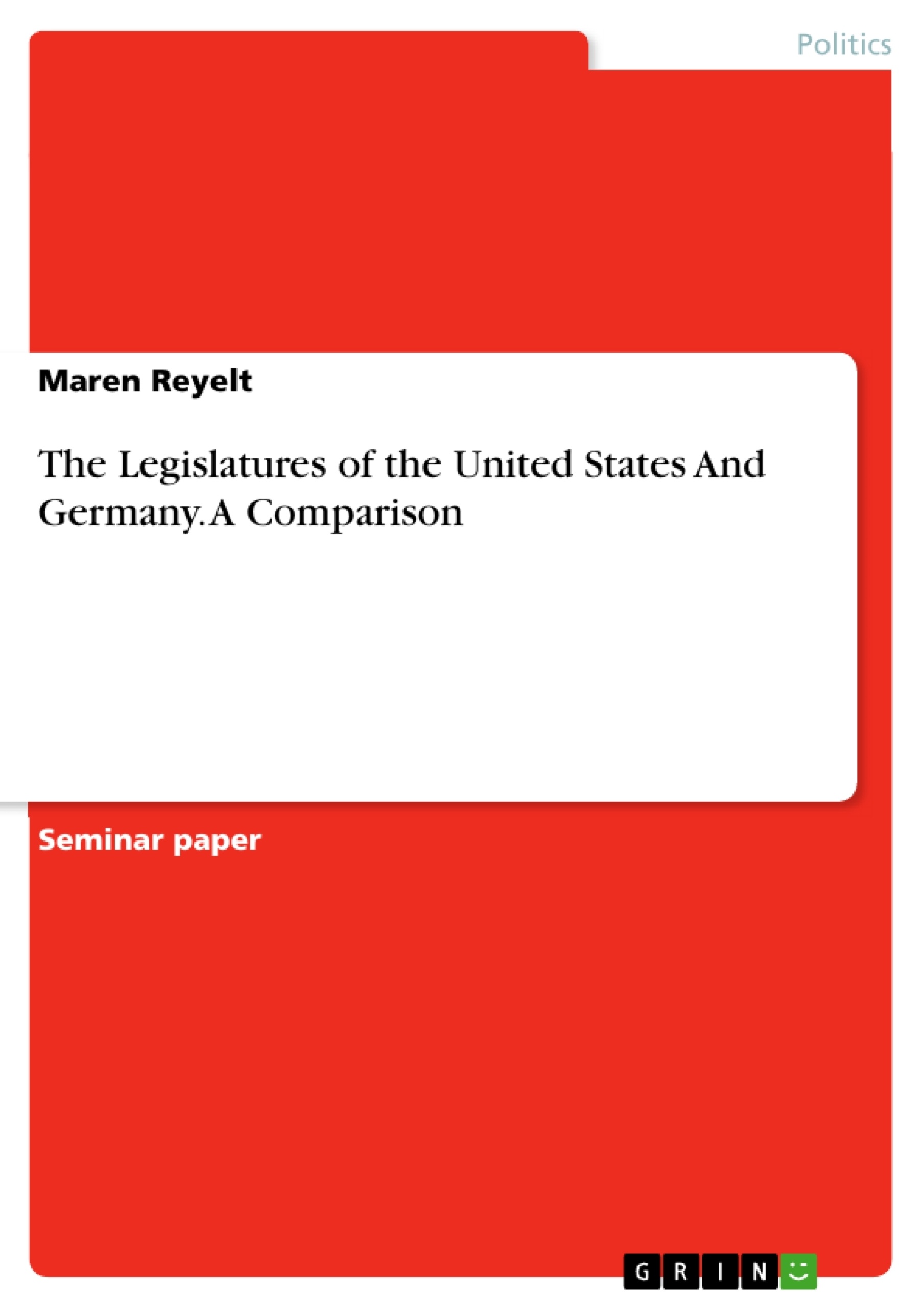“Legislatures have one core defining function: that of giving assent to measures that, by virtue of that as-sent, are to be binding on society. In practice, they have usually other roles as well, such as debating meas-ures or the conduct of public affairs. They have existed for centuries. They span the globe. Most countries have one; federal states have several.”
This statement applies to both institutions my paper deals with: to the United States Congress as well as to Germany’s parliament. The constitutional core of both political systems is actually a powerful bicameral parliament vested with the power to enact legislation. However, the structure of power of the American Congress in comparison to the German system is different in regard to the relationship of both chambers to each other on the one hand and to the executive on the other hand. But both institutions share the same essential functions of representing the people of their country, of counterbalancing the executive power and of developing legislation.
Germany’s political system is build upon a parliamentary structure, where the power of the executive depends on a prime minister or chancellor and his cabinet getting their mandate from the legislature and thus being responsible to and depending on the support of it. On the contrary, the United States features a presidential system, where the president is both head of the state and head of the government, independent from the legislature, which can be dominated by the oppos-ing party (divided government). But this does not mean that the two branches cannot be com-pared. Because of their position within the federal system (as described above) and the similar composition of the branches, a comparison is more than just possible. It was the high influence of the allied powers and in particular of the United States occupation policy after World War II that made the German parliament bicameral. Its first chamber, the Bundestag (Federal Diet) corresponds to the United States House of Representa-tives, the Bundesrat (Federal Council) is comparable to the United States Senate – although I have to admit, that Germany’s chambers are created unequal.
Table of Contents
- Introduction
- Constitutional Developments
- The Role of the American Congress: The Framer's Design
- Constitutional Background In Germany
- The Legislatures of the United States And the Federal Republic of Germany
- The United States Congress
- Organization And Functions of the United States Congress
- The House of Representatives
- The Senate
- Functions And Structure of the German Parliament
- The Bundesrat (Federal Council)
- The Bundestag (Federal Diet)
- The United States Congress
- Conclusion
Objectives and Key Themes
This paper aims to compare the legislative branches of the United States and Germany, focusing on their constitutional foundations, structures, and functions. It seeks to understand the similarities and differences between these two bicameral parliaments.
- The role of the legislature in democratic systems
- The constitutional design of bicameral legislatures
- The powers and functions of legislative branches
- The relationship between the legislature and the executive branch
- Historical influences on the development of these institutions
Chapter Summaries
- Introduction: This chapter introduces the core function of legislatures and outlines the key focus of the paper, which is to compare the United States Congress and the German Parliament. The author emphasizes the bicameral structure of both systems, highlighting the differences in power dynamics between chambers and their relationships with the executive branches.
- Constitutional Developments: This chapter explores the historical context surrounding the development of both legislatures. It examines the founding principles of the American Congress, including the separation of powers, the role of checks and balances, and the bicameral structure. The chapter then delves into the post-World War II constitutional background of Germany, focusing on the influence of the Allied powers, particularly the United States, in shaping the structure of the German Parliament.
- The Legislatures of the United States And the Federal Republic of Germany: This chapter provides a detailed comparison of the structure and functions of both the United States Congress and the German Parliament. It analyzes the organization and powers of the House of Representatives and the Senate in the United States, contrasting them with the Bundesrat (Federal Council) and the Bundestag (Federal Diet) in Germany.
Keywords
This paper focuses on the legislative branches of the United States and Germany, exploring key concepts such as bicameralism, separation of powers, checks and balances, parliamentary systems, presidential systems, constitutional development, and the influence of historical events on political institutions.
- Citation du texte
- Maren Reyelt (Auteur), 2001, The Legislatures of the United States And Germany. A Comparison, Munich, GRIN Verlag, https://www.grin.com/document/4313



